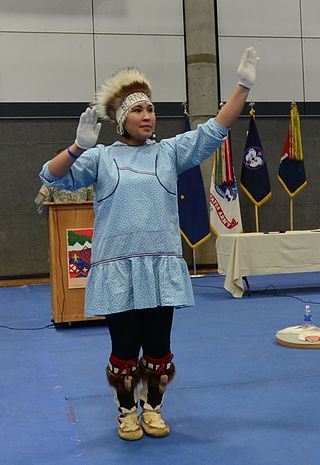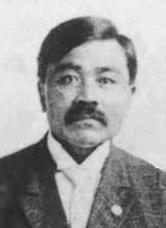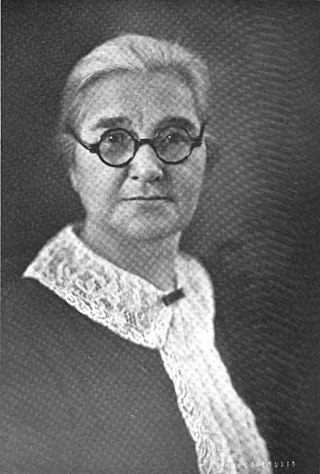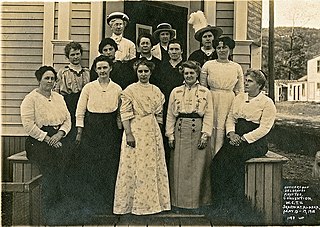
The Tlingit or Lingít are Indigenous peoples of the Pacific Northwest Coast of North America and constitute two of the 231 federally recognized Tribes of Alaska. Most Tlingit are Alaska Natives; however, some are First Nations in Canada.

Totem poles are monumental carvings found in western Canada and the northwestern United States. They are a type of Northwest Coast art, consisting of poles, posts or pillars, carved with symbols or figures. They are usually made from large trees, mostly western red cedar, by First Nations and Indigenous peoples of the Pacific Northwest Coast including northern Northwest Coast Haida, Tlingit, and Tsimshian communities in Southeast Alaska and British Columbia, Kwakwaka'wakw and Nuu-chah-nulth communities in southern British Columbia, and the Coast Salish communities in Washington and British Columbia.

Klawock is a city in Prince of Wales–Hyder Census Area, in the U.S. state of Alaska, on the west coast of Prince of Wales Island, on Klawock Inlet, across from Klawock Island. The population was 755 at the 2010 census, down from 854 in 2000. It is located 90 kilometres (56 mi) from Ketchikan, 11 kilometres (6.8 mi) from Craig, and 39 kilometres (24 mi) from Hollis.

Wrangell is a borough in Alaska, United States. As of the 2020 census the population was 2,127, down from 2,369 in 2010.

Alaska Natives are the Indigenous peoples of Alaska and include Russian Creoles, Iñupiat, Yupik, Aleut, Eyak, Tlingit, Haida, Tsimshian, and a number of Northern Athabaskan cultures. They are often defined by their language groups. Many Alaska Natives are enrolled in federally recognized Alaska Native tribal entities, who in turn belong to 13 Alaska Native Regional Corporations, who administer land and financial claims.

Sitka National Historical Park is a national historical park in Sitka in the U.S. state of Alaska. It was redesignated as a national historical park from its previous status as national monument on October 18, 1972. The park in its various forms has sought to commemorate the Tlingit and Russian experiences in Alaska.

Sealaska Corporation is one of thirteen Alaska Native Regional Corporations created under the Alaska Native Claims Settlement Act of 1971 (ANCSA) in settlement of aboriginal land claims. Headquartered in Juneau, Alaska, Sealaska is a for-profit corporation with more than 23,000 Alaska Native shareholders primarily of Tlingit, Haida, and Tsimshian descent.

Peter Simpson (1871?–1947) was a Canadian-born Tsimshian activist for Alaska Native rights, and co-owner of the first Indian-owned business in Alaska.

William Lewis Paul was an American attorney, legislator, and political activist from the Tlingit Nation in Southeast Alaska. He was known as a leader in the Alaska Native Brotherhood, and became the first Native attorney and first Native legislator in Alaskan history.

Elizabeth Peratrovich was an American civil rights activist, Grand President of the Alaska Native Sisterhood, and a Tlingit who worked for equality on behalf of Alaska Natives. In the 1940s, her advocacy was credited as being instrumental in the passing of Alaska's Anti-Discrimination Act of 1945, the first state or territorial anti-discrimination law enacted in the United States.

The history of the Tlingit includes pre- and post-contact events and stories. Tradition-based history involved creation stories, the Raven Cycle and other tangentially-related events during the mythic age when spirits transformed back and forth from animal to human and back, the migration story of arrival at Tlingit lands, and individual clan histories. More recent tales describe events near the time of the first contact with Europeans. European and American historical records come into play at that point; although modern Tlingit have access to those historical records, however, they maintain their own record of ancestors and events important to them against the background of a changing world.

Alaska Native Brotherhood Hall, or Sitka Camp No. 1, is significant for being the original chapter of the Alaska Native Brotherhood, an Alaska-wide Native organization. It is located on the waterfront in Sitka, Alaska, on Katlian Street.

The Brotherhood Bridge is a road bridge in Juneau, Alaska. The bridge carries the Glacier Highway over the Mendenhall River, acting as a demarcation point of sorts between the urban and rural portions of mainland Juneau. The bridge was named in honor of the Alaska Native Brotherhood (ANB). It was designed by civil engineer Roy Peratrovich, Jr., the son of Roy and Elizabeth Peratrovich, who were leaders in the ANB and counterpart Alaska Native Sisterhood. Bronze plaques on the bridge refer to the Raven and Eagle clans of the Tlingit people. Previous bridges across the Mendenhall River, at or near the same spot, were constructed in 1903, 1919 and 1931. It was entered into the United States Geological Survey's Geographic Names Information System on March 31, 1981.
Southeast Alaska Regional Health Consortium (SEARHC) is a non-profit medical, dental, vision and mental health organization serving the health interests of the residents of Southeast Alaska.

Matilda Kinnon "Tillie"' Paul Tamaree was a Tlingit translator, civil rights advocate, educator, and Presbyterian church elder.
Frank Peratrovich was an American businessman and politician.

Women's suffrage was won fairly easily for non-native women in Alaska in 1913. Prior to becoming a territory, non-native women were able to vote in school board elections. Women's suffrage work took place in the Alaska chapters of the Women's Christian Temperance Union (WCTU). After Alaska was admitted as a territory, the first Territorial Legislature passed a women's suffrage bill in 1913 and was signed into law on March 21. This law only applied to non-native women since Alaska Natives were not considered citizens of the United States. Alaska Natives continued to fight for the right to vote, along with other civil rights throughout the twentieth and twenty-first century.

This is a timeline of women's suffrage in Alaska. Non-native women in Alaska had the right to vote in school board elections starting in 1904. In 1913, the first Territorial Legislature passed the Shoup Suffrage Bill which gave non-native women the right to vote in all elections. Alaska Native women had a longer road fighting for their right to vote. First, they had to be declared citizens of the United States, but even after that happened in 1924, additional barriers were put in place. These included literacy tests and segregation. The Voting Rights Act of 1965 helped remove many barriers that Alaska Natives faced in exercising their right to vote.
In the history of discrimination in the United States, the Alaska Equal Rights Act of 1945 was the first state or territorial anti-discrimination law enacted in the United States in the 20th century. The law, signed on February 16, 1945, prevents and criminalizes discrimination against individuals in public areas based on race. The law came about after Alaska Natives fought against segregation and other forms of discrimination in Alaska.
















